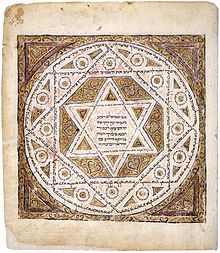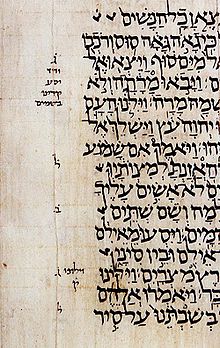- Leningrad Codex
-
The Leningrad Codex (or Codex Leningradensis) is the oldest complete manuscript of the Hebrew Bible in Hebrew, using the masoretic text and Tiberian vocalization.[1] It is dated AD 1008 (or possibly AD 1009) according to its colophon.[2] The Aleppo Codex, against which the Leningrad Codex was corrected, is several decades older, but parts of it have been missing since 1947, making the Leningrad Codex the oldest complete codex of the Tiberian mesorah that has survived intact to this day.
In modern times, the Leningrad Codex is most important as the Hebrew text reproduced in Biblia Hebraica (1937) and Biblia Hebraica Stuttgartensia (1977). It also serves scholars as a primary source for the recovery of details in the missing parts of the Aleppo Codex.
Contents
Contents
The biblical text as found in the codex contains the Hebrew letter-text along with Tiberian vowels and cantillation signs. In addition are masoretic notes in the margins. There are also various technical supplements dealing with textual and linguistic details, many of which are painted in geometrical forms. The codex is written on parchment and bound in leather.
The Leningrad Codex, in extraordinarily pristine condition after a millennium, also provides an example of medieval Jewish art. Sixteen of the pages contain decorative geometric patterns that illuminate passages from the text. The Signature Page shows a star with the names of the scribes on the edges and a blessing written in the middle.
The order of the books in the Leningrad Codex follows the Tiberian textual tradition, which also matches the later tradition of Sephardic biblical manuscripts. This order for the books differs markedly from that of most printed Hebrew bibles for the books of Ketuvim. In the Leningrad Codex, the order of Ketuvim is: Chronicles, Psalms, Job, Proverbs, Ruth, Song of Songs, Ecclesiastes, Lamentations, Esther, Daniel, Ezra-Nehemiah. The full order of the books is given below.
History
According to its colophon, the codex was copied in Cairo [1] from manuscripts written by Aaron ben Moses ben Asher. It has been claimed to be a product of the Ben-Asher scriptorium itself; however, there is no evidence that ben Asher ever saw it. Unusually for a masoretic codex, the same man (Samuel ben Jacob) wrote the consonants, the vowels and the Masoretic notes. It is believed to be the manuscript most faithful to ben Asher's tradition apart from the Aleppo Codex (edited by ben Asher himself). There are numerous alterations and erasures, and it was suggested by Moshe Goshen-Gottstein that an existing text not following ben Asher's rules was heavily amended so as to make it conform to these rules.
The codex is now preserved in the National Library of Russia, accessioned as "Firkovich B 19 A". Its former owner, the Karaite collector Abraham Firkovich, left no word in his writings where he had acquired the codex, which was taken to Odessa in 1838 and later transferred to the Imperial Library in St Petersburg.
Name
The Leningrad Codex (a codex as opposed to a scroll) is so named because it has been housed at the National Library of Russia in Saint Petersburg since 1863. As after the Russian Revolution Saint Petersberg in 1924 was renamed Leningrad, and because the codex was used as the basic text for the Biblia Hebraica since 1937, it became famous as "Leningrad Codex". At the Library's request "Leningrad" was retained in its name even after the city's original name was restored after the dissolution of the Soviet Union. Because of this renaming of the city in 1991, sometimes the Codex is referred to as Codex Petersburgensis or Petropolitanus, or the St. Petersburg Codex. Yet this name since 1876 refers to a different codex (MS. Heb B 3) which is even older (916 C.E.), but contains the (Later) Prophets only.
Modern editions
Biblia Hebraica
In 1935, the Leningrad codex was lent to the Old Testament Seminar of the University of Leipzig for two years while Paul E. Kahle supervised its transcription for the Hebrew text of the third edition of Biblia Hebraica (BHK), published in Stuttgart, 1937. The codex was also used for Biblia Hebraica Stuttgartensia (BHS) in 1977, and will be used for Biblia Hebraica Quinta (BHQ).
As an original work by Tiberian masoretes, the Leningrad Codex was earlier by several centuries than other Hebrew manuscripts which had been used for all previous editions of printed Hebrew bibles until Biblia Hebraica.
The Westminster Leningrad Codex is an online digital version of the Leningrad Codex maintained by the J. Alan Groves Center for Advanced Biblical Research at the Westminster Theological Seminary. This is a verified electronic version of BHS, with further proofreading and corrections. The online version includes transcription notes and tools for analyzing syntax.
Jewish editions
The Leningrad Codex also served as the basis for two important modern Jewish editions of the Hebrew Bible (Tanakh):
- The Dotan edition, which was reprinted with a concise commentary and distributed to soldiers in mass quantities as the official Tanakh of the Israel Defense Forces throughout the 1990s.
- The JPS Hebrew-English Tanakh (Philadelphia, 1999).
For minute masoretic details, however, Israeli and Jewish scholars have shown a marked preference for modern Hebrew editions based upon the Aleppo Codex. These editions use the Leningrad Codex as the most important source (but not the only one) for the reconstruction of parts of the Aleppo Codex that have been missing since 1947.
Sequence of the books
As explained in the Contents section above, this is different from most modern Hebrew bibles:
The Torah:
- 1. Genesis [בראשית / Bereishit]
- 2. Exodus [שמות / Shemot]
- 3. Leviticus [ויקרא / Vayikra]
- 4. Numbers [במדבר / Bamidbar]
- 5. Deuteronomy [דברים / Devarim]
The Nevi'im:- 6. Joshua [יהושע / Yehoshua]
- 7. Judges [שופטים / Shofetim]
- 8. Samuel (I & II) [שמואל / Shemuel]
- 9. Kings (I & II) [מלכים / Melakhim]
- 10. Isaiah [ישעיה / Yeshayahu]
- 11. Jeremiah [ירמיה / Yirmiyahu]
- 12. Ezekiel [יחזקאל / Yehezqel]
- 13. The Twelve Prophets [תרי עשר]
- a. Hosea [הושע / Hoshea]
- b. Joel [יואל / Yo'el]
- c. Amos [עמוס / Amos]
- d. Obadiah [עובדיה / Ovadyah]
- e. Jonah [יונה / Yonah]
- f. Micah [מיכה / Mikhah]
- g. Nahum [נחום / Nahum]
- h. Habakkuk [חבקוק /Habakuk]
- i. Zephaniah [צפניה / Tsefanyah]
- j. Haggai [חגי / Hagai]
- k. Zechariah [זכריה / Zekharyah]
- l. Malachi [מלאכי / Mal'akhi]
The Ketuvim- 14. Chronicles (I & II) [דברי הימים / Divrei Hayamim]
-
- The "Sifrei Emet," "Books of Truth":
- 15. Psalms [תהלים / Tehilim]
- 16. Job [איוב / Iyov]
- 17. Proverbs [משלי / Mishlei]
-
- The "Five Megilot" or "Five Scrolls":
- 18. Ruth [רות / Rut]
- 19. Song of Songs [שיר השירים / Shir Hashirim]
- 20. Ecclesiastes [קהלת / Kohelet]
- 21. Lamentations [איכה / Eikhah]
- 22. Esther [אסתר / Esther]
-
- The rest of the "Writings":
- 23. Daniel [דניאל / Dani'el]
- 24. Ezra-Nehemiah [עזרא ונחמיה / Ezra ve-Nehemiah]
See also
- Codex Cairensis
- Tanakh at Qumran
- List of Hebrew Bible manuscripts
References
- ^ The Codex Amiatinus and other manuscripts of translations are older.
- ^ Foreword by Gérard E. Weil to Biblia Hebraica Stuttgartensia, 1977.
External links
- The Unicode/XML Westminster Leningrad Codex, a digital text version transcribed from the Westminster Leningrad Codex maintained by the J. Alan Groves Center.
- Wikimedia Commons - full online digital images (book by book).
- Seforim Online - full online digital images (in a single large file). Number 264 in the database.
- The Leningrad Codex: A Facsimile Edition at Google books.
- Daniel D. Stuhlman, "Librarian's Lobby: The Leningrad Codex" (March 1998): occasioned by the photofacsimile edition.
- The Leningrad Codex (West Semitic Research Project at USC).
Categories:- 1008 books
- 11th-century biblical manuscripts
- 11th-century illuminated manuscripts
- Illuminated biblical manuscripts
- Jewish illuminated manuscripts
- Jewish Russian and Soviet history
- Visitor attractions in Saint Petersburg
- Hebrew Bible manuscripts
- National Library of Russia collection
Wikimedia Foundation. 2010.


